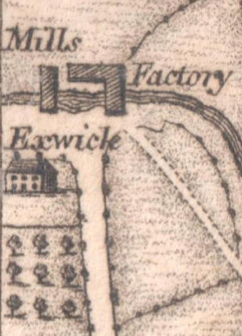



A Medieval Manor House ?
In some parts of Devon, as at Widecombe, the remains of moated medieval manor houses or halls, have been found. Their site layout and timber buildings can then be reconstructed, and we can gain an impression of what life might have been like in 13th century Devon, or earlier.
No evidence has yet been found for a medieval manor house or hall serving the small community of people who lived at Exwick manor. Nor for Exwick's larger administrative unit, perhaps a tithing, which appears to have become commonly referred to, sensu lato or generically, simply as 'Cowick' [see note 1]. However, little is known of the buildings of Medieval Exwick apart from a reference [see note 2] to there being a Chamber, a Grange, and a Mill (perhaps The Hermitage, Exwick Barton, and St Andrew's Mill).
A Tudor Manor House ?
The manor house of Exwick probably originated in in Tudor times; after the reformation which saw the centuries-old Priory of Cowick (by now part of Tavistock Abbey) 'dissolved' or stripped of its assets and role, in 1538. Exwick and Cowick were threupon granted by King Henry VIII to John Lord Russell, to become part of an enormous portfolio of private property and wealth in his hands. He and his descendants sold parcels off; and much of the Manors of Exwick and Cowick, were bought by mercantile families trading at, and often governing, the City of Exeter.
One such purchaser of Lord John Russell's former priory estates, was the Trosse family. In the early seventeenth century we find reports of 'Thomas Trosse of Exwicke' (d.1613/14) whose coat of arms and descendants were described in the Herald's Visitations to the County of Devon. His father, Peter Trosse, had been Bailiff of Exeter in 1555. Emlyne, a/the daughter of Tomas Trosse, was married at St. Thomas' church in 1601.
Later in the seventeenth century, Sir Benjamin Oliver (Mayor of Exeter 1670-71) who resided at Fore Street Hill when in Exeter, is described as having a country house at Exwick. This house, we learn, along with substantial barton lands in Exwick, descended through a line of Olivers and by their marriage to the Williams family, until the widowed Elizabeth Williams died in 1776. Her great-grandfather's Exwick Manor House (alias 'Exwick House') was then sold by her heirs.
These families - Trosse and Oliver - provide the earliest indications that Exwick had a Manor House in post-reformation times. The evidence suggests it originated as a Tudor mansion house (perhaps in Elizabethan times), built by a wealthy Exeter merchant familiy as a mansion with a substantial part of the Exwick barton lands.
In 1820 another 'Exwick House' was built close-by at Lower Mills, and the old Exwick Manor House was reaching the end of its days as a large mansion.
references
some can be provided as ocr copies avail and ask if these sources are reliable, etc ?
‘Replies: 'John Oliver Williams', and 'William Williams Esq. MD' ’ in : The Western Antiquary, or Devon and Cornwall Notebook. Ed. William Wright, vol 7, 1888, pp167-168 - online at Google Books.
'Trosse Family of Exeter' in Devon and Cornwall Notes and Queries, Jan.1965 to Oct 1967, pub. 1967, p138. available at Forum Library, University of Exeter.
The Visitations of the County of Devon : comprising the herald's visitations of 1531, 1564, & 1620 / with additions by Lieutenant-Colonel J. L. Vivian, by J. L. (John Lambrick) Vivian; pub. H. S. Eland, Exeter 1895, p.739 - online at Hathi Trust. [additional note - the italicised portion of the pedigree on p739 is said to be copy of the original Visitation of 1620, signed by Thomas Trosse's son and heir who was styled 'Henry Trosse of Exwick'. Thomas Trosse's wife (presumably living with him for a period in the early C17th at Exwick Manor House) was Rebecka (m.1609), daughter of a former Mayor of Exeter, Walter 'Borough', and his wife 'Rebecca'].
'Grant of Arms to Sir Benjamin Oliver, Knight', in Miscellanea Genealogica et Heraldica by William Bruce Bannerman, 1906 p.193 - online at Internet Archive.
[for the new Exwick House of 1820} see The Architectural Review, vol.47, April 1920, p.91-2 - online at Internet Archive.
The Monks of Cowick, by Geoffrey Yeo, 1987 [sold in aid of the St Thomas Church restoration appeal].
The reference to a Chamber, a Grange and a Mill is from the following Latin translation of the original : T O B E A D D E D
note 1: This term was commonly adopted for the two 'wicks' or manors of Cowick and Exwick as they became managed more closely as one entity by the Priors of Cowick (indeed in late medieval times his steward held a single manorial court over both according to G.Yeo 1987 p5).
note 2: ADD